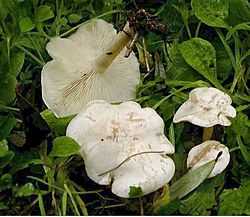Clitocybe dealbata
| Clitocybe dealbata | |
|---|---|
 | |
| Scientific classification | |
| Kingdom: | Fungi |
| Division: | Basidiomycota |
| Class: | Agaricomycetes |
| Subclass: | Hymenomycetes |
| Order: | Agaricales |
| Family: | Tricholomataceae |
| Genus: | Clitocybe |
| Species: | C. dealbata |
| Binomial name | |
| Clitocybe dealbata (Sowerby) Gillet (1874) | |
| Clitocybe dealbata | |
|---|---|
|
| |
| gills on hymenium | |
| cap is depressed | |
| hymenium is adnate | |
| stipe is bare | |
| spore print is white | |
| ecology is saprotrophic | |
| edibility: poisonous | |
Clitocybe dealbata, also known as the ivory funnel, is a small white funnel-shaped toadstool widely found in lawns, meadows and other grassy areas in Europe and North America. Also known as the sweating mushroom, it derives this name from the symptoms of poisoning. It contains potentially deadly levels of muscarine.
Taxonomy and naming
Clitocybe dealbata was initially described by British naturalist James Sowerby in 1799 as Agaricus dealbatus,[1] its specific epithet derived from the Latin verb dealbare 'to whitewash'.[2] It gained its current name in 1874 when reclassified by French naturalist Claude Casimir Gillet.[3] However, this species is often considered a synonym of Clitocybe rivulosa [4] and according to Bon [5] the name C. dealbata may be invalid (a nomen dubium) as Sowerby's definition conflicts with Fries's.
Description
A small white or white dusted with buff-coloured mushroom, the 2–4 cm diameter cap is flattened to depressed with adnate to decurrent crowded white gills. The stipe is 2–3.5 cm tall and 0.5–1 cm wide. The spore print is white. There is no distinctive taste or smell.[6]
It is one of a number of similar poisonous species such as the false champignon (Clitocybe rivulosa) which can be confused with the edible fairy ring champignon (Marasmius oreades),[7] or miller (Clitopilus prunulus).[8]
Distribution and habitat
The ivory funnel is found in grassy habitats in summer and autumn. Often gregarious, it can form fairy rings.[9] Unfortunately, they often occur in grassy areas where they may be encountered by children or toddlers. This may increase risk of accidental consumption.[10]
Toxicity
The main toxic component of Clitocybe dealbata is muscarine, and thus the symptoms are those of muscarine poisoning, namely greatly increased salivation, sweating (perspiration), and tearflow (lacrimation) within 15–30 minutes of ingestion. With large doses, these symptoms may be followed by abdominal pain, severe nausea, diarrhea, blurred vision, and labored breathing. Intoxication generally subsides within two hours. Death is rare, but may result from cardiac or respiratory failure in severe cases. The specific antidote is atropine.[10]
References
- ↑ See File:Coloured Figures of English Fungi or Mushrooms - t. 123.png for the plate which is the original definition of this species.
- ↑ Simpson, D.P. (1979). Cassell's Latin Dictionary (5 ed.). London: Cassell Ltd. p. 883. ISBN 0-304-52257-0.
- ↑ Gillet CG (1874) Les Hyménomycètes 828pp
- ↑ Kuyper, Thomas W. (1996). "Some taxonomic and nomenclatural changes in the Tricholomataceae, tribus Clitocybeae". Persoonia. 16 - 2.
- ↑ Bon, Marcel (April 1997). Flore mycologique d'Europe 4 Les clitocybes, omphales et ressemblants. Flore mycologique d'Europe. Quai Jeanne d'Arc, 80230 St. Valéry-sur-Somme, France: M. Bon. p. 61.
- ↑ Phillips R (1985). Mushrooms of Great Britain and Europe. Pan Books. ISBN 0-330-26441-9.
- ↑ Carluccio A (2003). The Complete Mushroom Book. Quadrille. ISBN 1-84400-040-0.
- ↑ Nilson S & Persson O (1977). Fungi of Northern Europe 2: Gill-Fungi. Penguin. p. 98. ISBN 0-14-063006-6.
- ↑ Haas H (1969). The Young Specialist looks at Fungi. Burke. p. 132. ISBN 0-222-79409-7.
- ↑ 10.0 10.1 Benjamin DR. (1995). Mushrooms, Poisons and Panaceas: A Handbook for Naturalists, Mycologists, and Physicians. W H Freeman & Co. ISBN 0-7167-2649-1